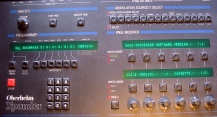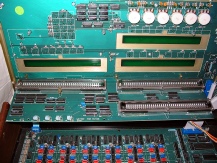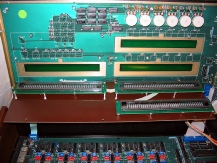Background
The Oberheim Xpander and Matrix-12 each use three 40-character VFDs (Vacuum Fluorescent
Displays) to communicate with the user. VFDs have admirable brightness and contrast
and the majority of units are still working well after more than 20 years.
However, for a couple of reasons there is a small but growing minority of owners
suffering from display problems which either degrade or, at worst, prevent use of
their instruments. Firstly, being constructed predominently of glass, VFDs are fragile
and accidents during shipping or servicing can damage them. Secondly, VFDs will,
eventually, wear out with use, losing their luminance and/or developing faults with
individual characters. This is the same slow process which affects thermionic valves
(tubes), to which they are closely related.
The Oberheim displays were manufactured by Itron (type FG405) and are 16-segment
"starburst" types. It is well-known that these parts are long out-of-production and
very hard, if not impossible, to get hold of. While Itron are still actively manufacturing
VFDs, because technology has moved forward in the last 20 years they now have nothing
directly compatible. Not only do most modern displays use dot-matrices rather than
starburst arrays, but they also tend to incorporate a great deal more intelligence
into the display itself.
A new solution
There has been much discussion about the integration of modern VFDs into the Oberheim
synths, but to do so presents many technical difficulties, primarily caused by the
very different data interface fitted to the modern displays.
I am pleased to say that these issues have now been overcome here at Benden Sound
Technology. My OB-VFD upgrade utilises three Itron DN4015B displays - closest in
dimensions to the original parts - and a microcontroller-based interface which accepts
data directly from the Oberheim main board and parses it into the serial data stream
required by the display modules. It also converts the original starburst data into
smoothly-defined 7x5 dot-matrix characters.
The OB-VFD upgrade replaces the original Oberheim display PCB completely. It is therefore
very easy to fit and, apart from one simple modification to the power supply to adjust
a bias voltage, requires no other changes to the original instrument.
The DN4015B is still in production at Itron and no other obsolescent parts are used,
so the OB-VFD upgrade will significantly extend the useful lifetime of your instrument.
Questions Answered
Q: What is it?
A: The OB-VFD upgrade is a fully-tested circuit board that is equivalent in both
form and function to the display PCB used by Oberheim in the Xpander and Matrix-12
synthesisers. It uses modern vacuum fluorescent displays to replace the aging or
faulty originals and extend the life of the instrument.
Q: Will it fit my synth?
A: The OB-VFD upgrade will fit all Xpanders and Matrix-12s that were built in the
USA. Most were, but a small number were also manufactured in Japan using a somewhat
modified design. Japanese synths do not have their displays mounted on a separate
circuit board, so the upgrade cannot be fitted. Please check your synth before ordering
- the country of manufacture should be visible on the rear panel label.
Q: Can I fit it myself?
A: If you can use basic hand tools (screwdriver, pliers) and accurately solder a
two-legged component across two pads on a circuit board, you can install the OB-VFD
upgrade. The upgrade fits exactly in place of the existing display PCB using the
same fasteners and connectors, and the only other task is to solder a new diode to
top of the existing power supply PCB (this modifies a bias voltage to suit the new
displays). The PCB does not need to be removed.
Q: Only one of my three displays is faulty. Can I replace just that one?
A: Unfortunately not, for two reasons. First, the new displays require a slightly
different bias voltage to the originals and hence cannot co-exist with them. Secondly,
and more importantly, the signals sent to the original displays are so different
to those required by the new VFDs that it was impractical to produce a pin-compatible
replacement. Instead, we must replace the entire Oberheim display board, intercepting
the raw data coming straight from the Oberheim's microprocessor and distributing
it to all three new displays.
Q: Will it be reliable and long-lived?
A: Only new components, still in production, are used. If desired, spare displays
can be supplied for even greater future-proofing.
Q: Are there any differences in functionality from the original displays?
A: The OB-VFD upgrade receives the same data and displays the same information as
the original displays. The only differences that can be observed are:
- The new dot-matrix characters look different - they are clearer and better defined!
- The active width of the new displays is approximately 7mm less than the originals
(less than 4% different). This is negligible in use and the panel markings still
align well with the displayed data.
- The odd non-alphanumeric starburst characters offered for use in patch names have
been reinterpreted as recognisable symbols (Greek characters, smileys, etc). The
TV is still present!
- The original displays had a decimal point attached to each character which Oberheim
used to indicate that a parameter had been changed but not saved. The new displays
have no separate decimal point, so the bottom-right pixel of the dot-matrix character
is blinked slowly when such an indication is required.
Q: How much does it cost?
A: The cost of the upgrade is UK£325 plus shipping to wherever you are. Of course,
this may be offset by reselling any usable parts from your original display board
;-)
Q: Are they available to buy?
A: The OB-VFD upgrade is now in full production, with many units successfully installed.
Units are generally available from stock for immediate shipping. Please contact us
for more details or to place an order.









